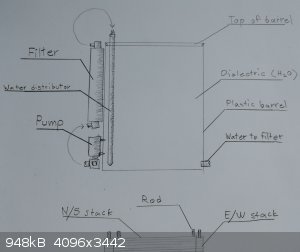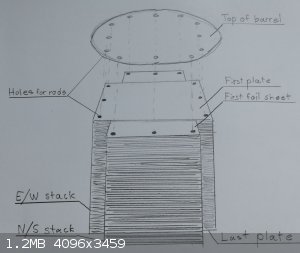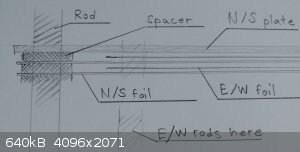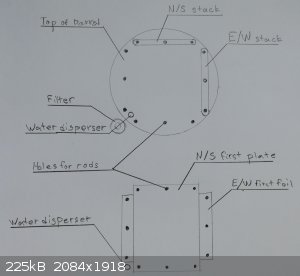Σldritch
Hazard to Others
  
Posts: 309
Registered: 22-3-2016
Member Is Offline
Mood: No Mood
|
|
DIY High Energy Capacitor for pulsed power
I find myself thinking about pulsed power a lot and how to do it affordably. I think i may have found a solution for those of us not blessed with
cheap capacitors; building one yourself! To keep it short water capacitors seem to be the best option due to the following:
1. Readily available
Does not need further explanation
2. Fairly high permittivity-breakdown voltage (is there a word for this?)
C = ε0•εr•A /d and E = C•U2 /2 can be combined to E = ε0•εr•A•U2
/2•d . Then we can plug in the rearranged Ubreakdown = U /d
and rearrange again to get E/A = ε0•εr•Ubreakdown2•d /2 , a best case of how much energy we can
can store in it. Notice that higher breakdown voltage gives better energy storage faster than permittivity.
3. Balanced permittivity and breakdown voltage
We will not need extremely thin capacitors (diamond capacitor) or an unreasonable amount of capacitors in series (supercapacitors) to get voltages
useable for pulsed power.
4. Regenerating
If the water breaks down it does not necessarily render the capacitor useless. (With this high energy it may destroy the plates though).
5. Fills voids easily
It does not need to be pressed and sintered like ceramics.
Take this with a spoonful of salt, this is my own reasoning, not from any non-mad source. Obviously this would also be extremely dangerous, i do not
take responsibility.
With the dielectric so readily available how should the capacitor itself be constructed? Below in the pictures is an idea. Sadly i doubt i will be
able to build it for some time due to other projects but i decided to put it here so i do not forget anything and maybe inspire some more physics on
Sciencemadness.
Here are some notes on performance:
Wikipedia gives a value of 65-70Mv/m to the breakdown voltage of water. If using 4mm spacers it should give a good voltage of 130-140kv (spacers
are half length of gap), 100kv with some margin. Water has a relative permittivity of around 80 which should give about 56.66 nF per layer if the
plates have an area of 0.42 m2 . If the barrel is a meter long that is 500 layers with a total capacitance of 28.33 μF . If
charged to 100kv that should give an amazing 141665.6 J , equivalent of 27g of TNT if memory serves. I am doubt whether the capacitor would hold up at
those energies or not as water, unlike plastic or ceramic dielectrics, does not provide much structural support. Again, if memory serves it will
produce a minimum pressure of 8.8 athmospheres inwards on the top and bottom of the stacks where the plates are not pulled in both directions which is
why i wrote plates imagining the use of a thicker piece of metal than foil to hold it together. Plastic structural support should probably be added
between the rods too.
And here are some problems that i can foresee:
If the aluminium foil buckles it could create a point where the resistance is low enough to create a corrosion or even a breakdown so it will
need some tension. I can imagine solving this problem by running an insulating string through the stacks (with knots if it does not expand in water)
and pulling it, buckling all the foil in the same direction keeping the gap constant. Another problem could be the complexity and expense added by the
deioniser, especially in miniature versions. Perhaps it can be replaced by just filling the bottom of the barrel with some deionising resin. Anything
else?
   
[Edited on 1-4-2019 by Σldritch]
|
|
|
Sulaiman
International Hazard
    
Posts: 3558
Registered: 8-2-2015
Location: 3rd rock from the sun
Member Is Offline
|
|
Have a look at Tesla Coil websites for lots of information on pulse-rated and diy capacitors.
I have stacked, and rolled, my own a few times - now I only buy.
Water sounds good
... if the metal ions from the electrodes do not cause the water to become conductive 
CAUTION : Hobby Chemist, not Professional or even Amateur
|
|
|
wg48temp9
National Hazard
   
Posts: 761
Registered: 30-12-2018
Location: not so United Kingdom
Member Is Offline
|
|
Yes water has been used in capacitors. The problem with water is its a leaky dielectric. So leaky it has to be charged and discharge quickly or the
charge will be lost.
I think it was Imperial collage London that a a multi stage water capacitor for high energy discharge experiments. The capacitors where transmission
lines consisting of metal plates housed in a large tank of purified water several meters in each dimension. The water was continuously circulates
through filters and ion exchange resins to reduce it conductivity due to ions other than water.
In order to charge the first line quickly it was charged by discharging a Marx generator into in microseconds. The Marx generator was a bank of in
house made rolled polypropylene capacitors with a volume of about two cubic meters. The Marx capacitors charge time was minutes so this made its
power supply practical as its peak power was millions of times less the peak power required to charge the water capacitor directly in a sufficiently
short time to make it leakage current not significantly effect the storage capacity. That also means that the breakdown voltage is increased as the
break down take time to form.
I assume you would have the same problem. I suggest you consider what leakage resistance of pure water can be achieved to determine how quickly it
needs to be charged and discharged.
I am wg48 but not on my usual pc hence the temp handle.
Thank goodness for Fleming and the fungi.
Old codger' lives matters, wear a mask and help save them.
Be aware of demagoguery, keep your frontal lobes fully engaged.
I don't know who invented mRNA vaccines but they should get a fancy medal and I hope they made a shed load of money from it.
|
|
|
Σldritch
Hazard to Others
  
Posts: 309
Registered: 22-3-2016
Member Is Offline
Mood: No Mood
|
|
It should have an internal resistance of 45000 Ohm and a discharge current of 0.22 A at 100000 V , not very useful. I wonder if passivation of the
aluminium foil would reduce it though, i never really intended it for AC anyway. I guess its back to CCTO and EPFCGs again 
EDIT: It seems to increase sharply with a decrease in temperature though. 18 MOhm/cm at 25 C and 40 MOhm/cm at 10 C (date is for ultrapure). Perhaps
you could get some use out of it at 1 C
[Edited on 1-4-2019 by Σldritch]
|
|
|
unionised
International Hazard
    
Posts: 5102
Registered: 1-11-2003
Location: UK
Member Is Offline
Mood: No Mood
|
|
For cold pure water the resistivity is 0.18 Mohm metres.
And the dielectric constant is about 80 and the permittivity of a vacuum is 8.85 x 10^-12 f/m
So a metre cube of water with electrodes on opposite faces would have a resistance of 180000 ohms and a capacitance of 80 * 8.85 x 10^-12 F
If I have the maths right that gives it a time constant of about 130µseconds
Interestingly, it doesn't matter what shape + size the capacitor is, the time constant remains the same.
The resistivity of anhydrous hydrogen cyanide is higher than that of water and the dielectric constant is also higher (about 100, depending on
temperature).
So, if you made a capacitor with metal plates in liquid hydrogen cyanide...
... you would die.
Probably from toxicity, but possibly from the fact that the stuff is also explosively unstable
This bit of the OP
4. Regenerating
If the water breaks down it does not necessarily render the capacitor useless.
does not apply here.
I have never heard of anyone making an acetonitrile filled capacitor.
I'm not sure I want to.
[Edited on 1-4-19 by unionised]
|
|
|
Vomaturge
Hazard to Others
  
Posts: 285
Registered: 21-1-2018
Member Is Offline
Mood: thermodynamic
|
|
I agree with unionised. I think the self discharge time constant (time required for 63% of the voltage and 93% of the energy to discharge) is about
130 microseconds with normal distilled water, and will get worse due to impurities from the plates. The resistance will be about 3.64 ohm, the
capacitance 35uf, and the leakage current will be (unfortunately) 27.5 kA more or less at 100kv.
Nonetheless, it might make sense to build a smaller water capacitor (with extremely low series resistance and inductance) charge it up over the better
part of a microsecond using e.g. a bank of microwave capacitors (or charge the big one with the epfcg you mentioned  ) and then discharge the newly charged water cap in a nanosecond timescale pulse. ) and then discharge the newly charged water cap in a nanosecond timescale pulse.
Where I've found there is a benefit to diy capacitors is for 10's of kv, and a few nf. Using cookie sheets, tin foil, and plastic notebook dividers,
you can create capacitors with performance which would otherwise require some pretty expensive (because it's specialized, and not many are built) and
hard to find equipment. this site has what I think look like good 'recipes', having made similar (but less optimized) contraptions myself. They won't carbonize bananas
and shatter glass bottles, but these caps might be perfect to, say, couple a few little calories of UHF energy into your neighbors annoying stereo in
a 100 nanosecond timeframe.
Have fun, and don't get shocked
[Edited on 1-4-2019 by Vomaturge]
|
|
|
unionised
International Hazard
    
Posts: 5102
Registered: 1-11-2003
Location: UK
Member Is Offline
Mood: No Mood
|
|
The trouble with nanosecond timescales and water caps is that the speed of EM radiation in water (near these frequencies) is about 9 (the square root
of the dielectric constant) times less than in air
If you want things to happen in a nanosecond in air you need stuff that is smaller than about 30cm.
In water you need it to be smaller than about 3cm.
OK for 100 ns you get a much easier job, but if you want UHF, you are in the range of a few inches or less.
|
|
|
Vomaturge
Hazard to Others
  
Posts: 285
Registered: 21-1-2018
Member Is Offline
Mood: thermodynamic
|
|
When I was talking about "nanosecond timescale" I was thinking of tens of nanoseconds, using a small water capacitor as a pulse forming network to
absorb a pulse from a bigger, slower capacitor bank and then rapidly discharge it. It can hold an outsized amount of energy for a sub microsecond
time, and for much cheaper than e.g. an oil filled capacitor. I doubt you could get much energy out in a single ns, though.
At the end, I was mostly saying that a) you won't be making a 100kj capacitor at home, at least not cost effectively, and b) the plastic dielectric
diy capacitors do hold enough energy to do some interesting stuff. My specific idea for creating a 100ns pulse of uhf was a big marx bank of those DIY
plastic insulated capacitors feeding just a few hundred joules to a microwave oven magnetron immersed in oil at the focal point of a satellite dish or
diy antenna. Would a magnetron even be able to work efficiently at greatly increased voltages? Would a marx generator design have too much inductance?
How directional of a beam could you hope to get out of a dish antenna? Would it cause dielectric breakdown in air? It all neads better calculations,
and those are for a whole new thread. I can already see that the magnetron's impedance would be a huge issue. A lot of fun to think about, if
impractical.
|
|
|
wg48temp9
National Hazard
   
Posts: 761
Registered: 30-12-2018
Location: not so United Kingdom
Member Is Offline
|
|
I failed to find any details of the set up at Imperial collage London I referred to in my last post. I did find a note on the early history of western
pulsed power which may be of interest.
Attachment: pulsepower01710017.pdf (2.6MB)
This file has been downloaded 363 times
and an EMP generator
Attachment: 5ns100kVpulsegenerator.pdf (786kB)
This file has been downloaded 336 times
I am wg48 but not on my usual pc hence the temp handle.
Thank goodness for Fleming and the fungi.
Old codger' lives matters, wear a mask and help save them.
Be aware of demagoguery, keep your frontal lobes fully engaged.
I don't know who invented mRNA vaccines but they should get a fancy medal and I hope they made a shed load of money from it.
|
|
|